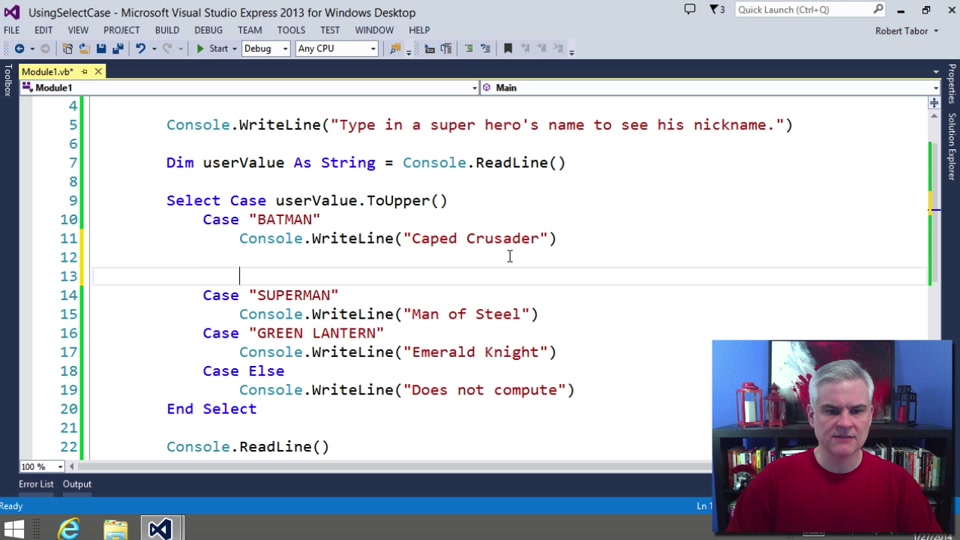Description
You've just created a basic navigation form. You should be able to move to other rows. ADO3.JPG There are many improvements that can be done here. The code to fill up the fields can be placed in a single method to which you pass a parameter. You'll see this in the next part of the tutorial, along with adding, updating, and deleting. Hello folks, Visual Basic.net is an easy to learn language from Microsoft for the windows platform.One of the cool features of Visual Basic.net is the ability to whip up good looking gui components with a few lines of code.
Welcome to this series of lessons about the Visual Basic programming language. Bob Tabor from LearnVisualStudio.NET introduces the topic, sets expectations and tips on how to get the most out of this series, instructs you on where you can download the software you'll need to get started and offers some encouragement as you begin your journey.
Full course outline:
- Mod 01: Series Introduction
- Mod 02: Installing Visual Studio Express 2013 for Windows Desktop
- Mod 03: Creating Your First Visual Basic Program
- Mod 04: Dissecting the First Visual Basic Program You Created
- Mod 05: Quick Overview of the Visual Basic Express Edition IDE
- Mod 06: Declaring Variables and Assigning Values
- Mod 07: Branching with the If.Then.Else Decision Statement
- Mod 08: Operators, Expressions and Statements
- Mod 09: For.Next Iterations
- Mod 10: Creating Arrays of Values
- Mod 11: Creating and Calling Simple Overloaded Helper Methods
- Mod 12: While Iterations and Reading Data from a Text File
- Mod 13: Working with Strings
- Mod 14: Working with Dates
- Mod 15: Understanding and Creating Classes
- Mod 16: More about Classes and Methods
- Mod 17: Working with Classes and Inheritances in the .NET Framework Class Library
- Mod 18: Understanding Namespaces and Adding References to Assemblies
- Mod 19: Understanding Modules, Scope and Utilizing Accessibility Modifiers
- Mod 20: Enumerations and the switch Decision Statement
- Mod 21: Gracefully Handling Exceptions
- Mod 22: Working with Collections
- Mod 23: Filtering and Managing Data in Collections using LINQ
- Mod 24: Understanding Event Driven Programming
- Mod 25: Getting Familiar with the My Namespace
- Mod 26: Where To Go From Here
Embed
Download
Right click or Alt+Enter to download this episode
- MP3 (4.7 MB)
- Low Quality MP4 (8.0 MB)
- High Quality MP4 (30.3 MB)
- Mid Quality MP4 (20.1 MB)
How to write a visual basic program. Visual Basic programs for beginners with examples. How to print a string in visual basic. below are some examples of visual basic programs.
In this tutorial, Will see some basic string operation like how to print string and char in visual basic. Check thevisual basic program for mathematical operations.
Let’s start with the basic “Hello World” Project in Visual basic. Start any programming language with some string operation is a really good idea.
Write a visual basic program to print a string “Hello World”
The below code will print the string value “Hello World”. Console.WriteLine(” “) is used to print any value as an output and the Console.ReadLine() is used to read the next line here we are using it to hold the screen.
Output: Hello World
Visual basic program to print a string variable.
Age of empires 2 definitive edition on xbox. Declare a variable in visual basic is really simple. here in the below code. Dim str As String is a variable decoration. Where str is a variable of string type.
Output: Write First Program in Visual basic
How to Concat two string in Visual basic.
+ or the & operator is used to Concat two or more string in Visual basic. Below is the code to Concat two string in visual basic. Which contains 3 strings str1, str2,str3.
Output: Visual basic program
Please check more examples on visual basic program for beginner
Visual Basic programs with example
Basic Vb programs
| Example 2.1.1 |
| Example 2.1.2 |
You can also use the + or the & operator to join two or more texts (string) together like in example 2.1.4 (a) and (b)

| Example 2.1.4(a) Private Sub A = “Tom” End Sub | Example 2.1.4(b) Private Sub A = “Tom” End Sub |
Write a VB program to convert Celsius to Fahrenheit